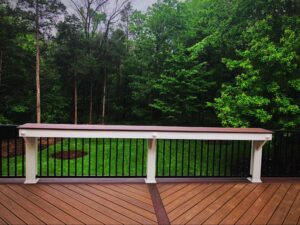Your patio is the best place to relax after a long, tiring day at work. Even during winter, you can still enjoy your patio by winterizing it. However, during heavy snow, your patio and patio pavers might need serious cleaning before you can enjoy them. Would you want your patio pavers to look unsightly because of the snow covering it?

Winter weather damage
Winter doesn’t just bring your cold feet in the morning, it can also harm your patio pavers. During winter, some parts of the ground freeze over; then warms up and thaws when the sun appears. The cycle of the ground freezing over and then thawing out the next day will result in a movement in the uppermost surface of the ground. This movement directly affects the objects on the surface including the patio pavers. Thus, creating cracks or gaps in the joints of the pavers. If you don’t have a patio cover protecting your pavers, you could end up needing repairs or a replacement.
Ice melt
A patio or walkway with pavers made of compacted materials may experience little damage from the freeze-thaw cycle during winter. However, in most homes with average pavers will definitely display noticeable damage. With this, many homeowners employ solutions that can help them protect their patio pavers against the harsh winter weather — including the use of ice melt. Ice melt is usually made from a combination of active ingredients such as:
- Sodium chloride
- Calcium chloride
- Magnesium chloride
- Potassium chloride and urea
Ice melt works by attracting moisture to form a liquid brine, creating heat that can melt the ice in the process. Ice melt should reach the pavers to make it effective. Once it is put on patio pavers, it can spread out on the ice and break its bond with the patio pavers. When the ice is loosened away, it would be easier to shovel and get rid of the snow.
Is Ice Melt safe to use?
The use of ice melt on patio pavers has been a subject of debate by many homeowners for some time now. Many believed that it can be corrosive to concrete pavers, making more damage. The sodium chloride in the ice melt is typically used as a de-icing agent on asphalt road. However, it can only be used on asphalt road. If used in other materials, it may bleach the surfaces and cause flaking. In fact, high levels of sodium chloride are harmful to plants.
Fortunately, there are ways you can do to make ice melt useful in de-icing your frozen patio pavers. You see, the harmful component in ice melt is sodium chloride; so, the key here is to reduce its level to make it less damaging. How?
Here are some tips that you can do to ensure that your patio paver is safe from getting damage:
- Mix it up. Mix your ice melt with an abrasive so you can reduce the amount of salt. That way, your patio pavers will not crack or deteriorate and at the same time, abrasives can provide more traction, allowing you to remove the ice easier.
- Lay it in layers. Apply ice melt on a thin layer before a storm and add another layer during the storm.
- Do not use ice melt on new concrete.
- Wear gloves when applying ice melt. When chemicals come in contact with your skin, it can cause irritation.



